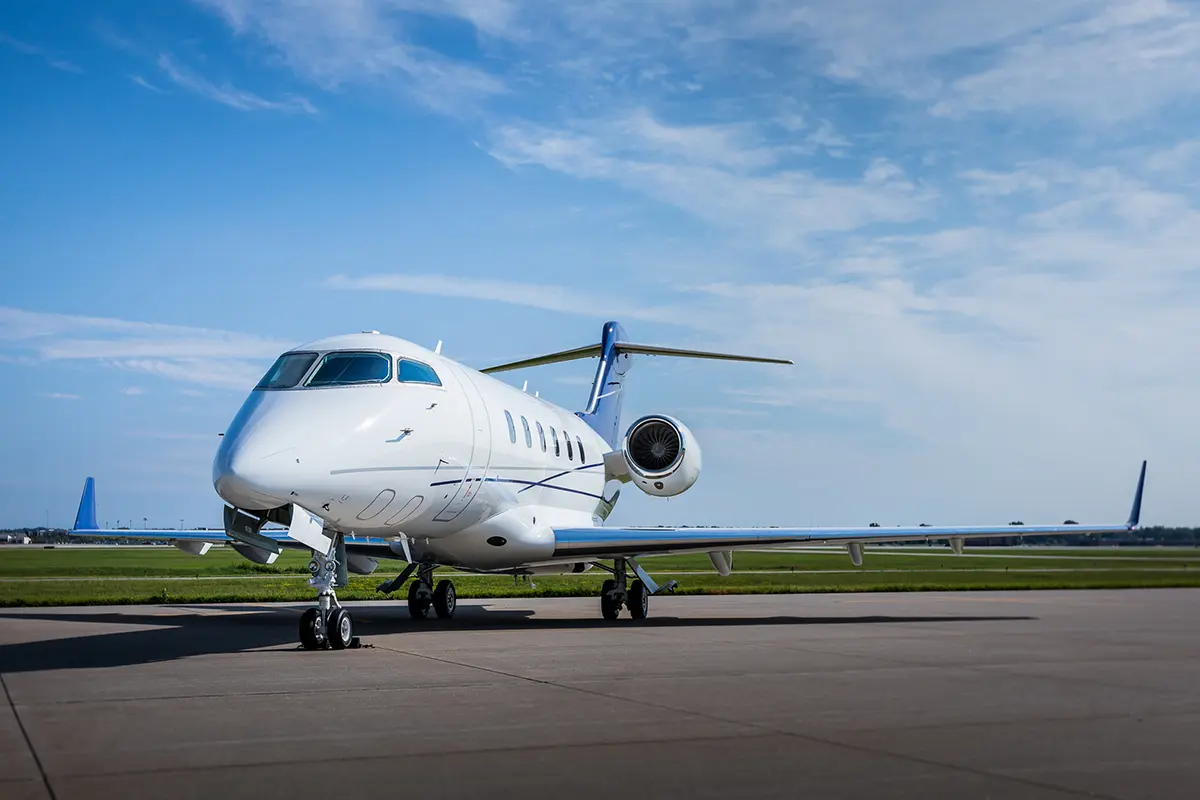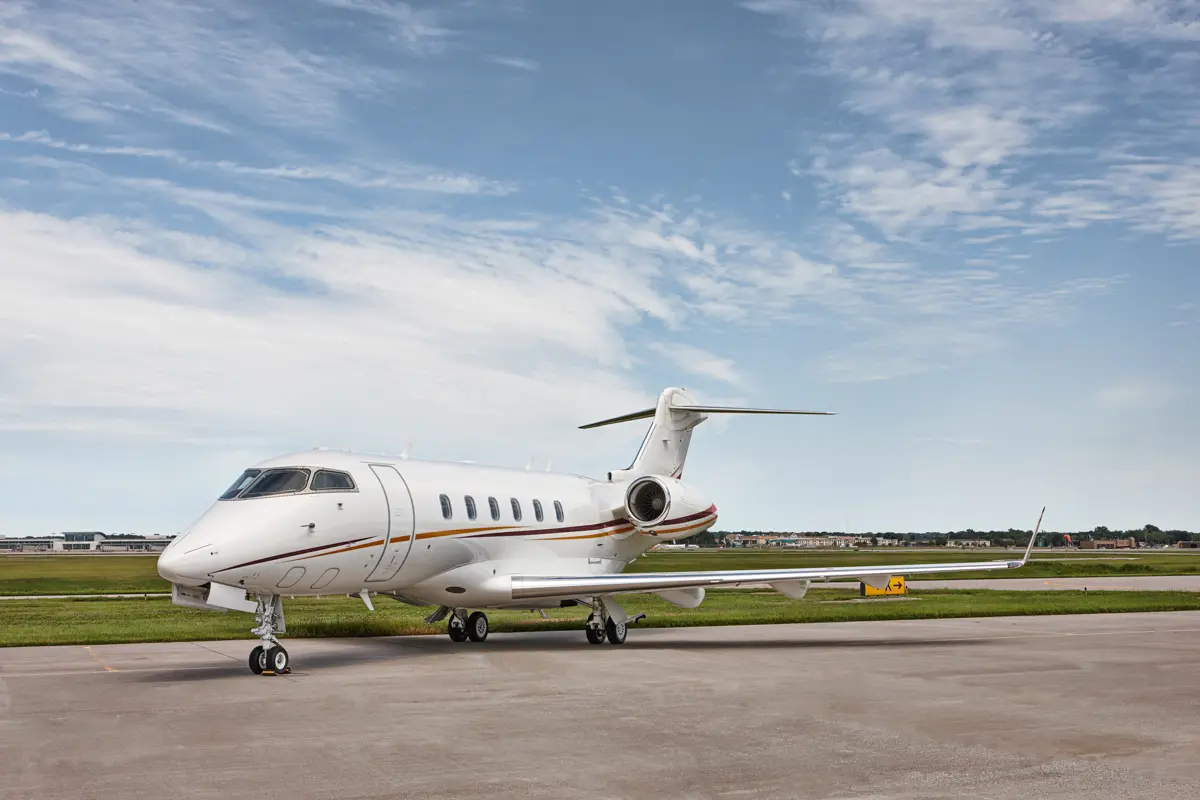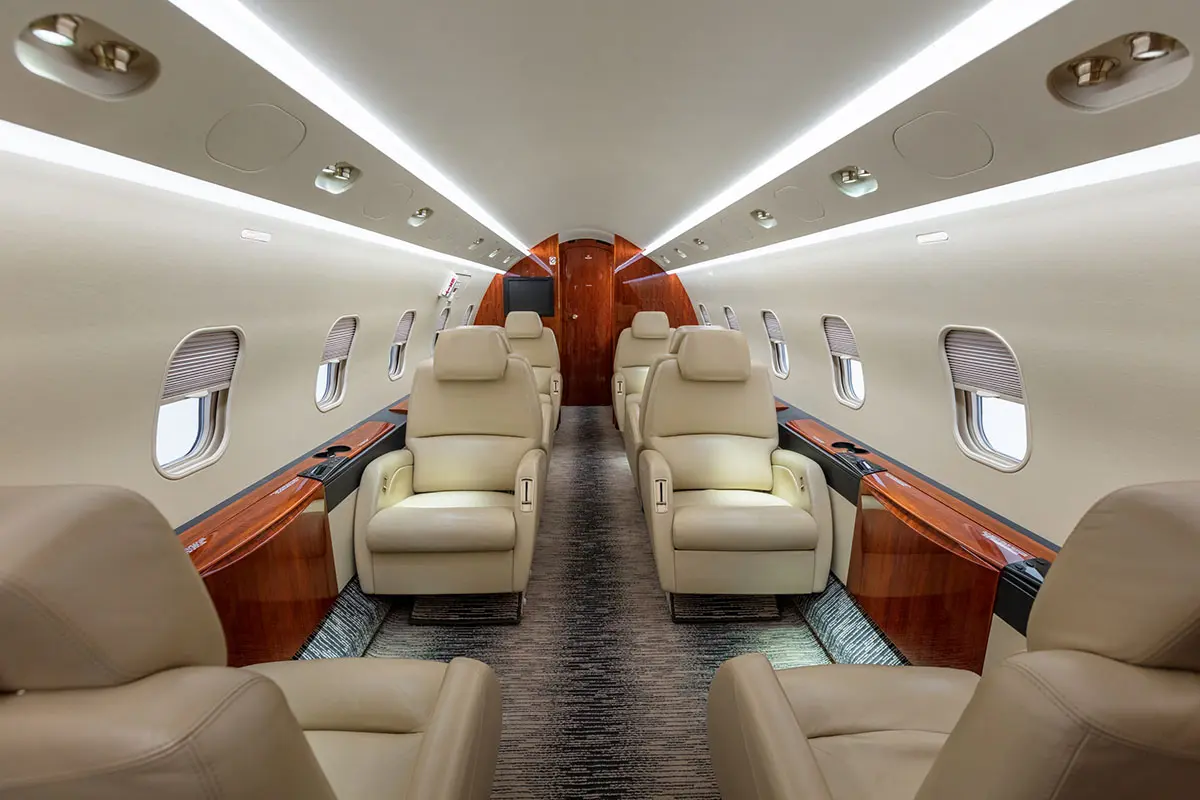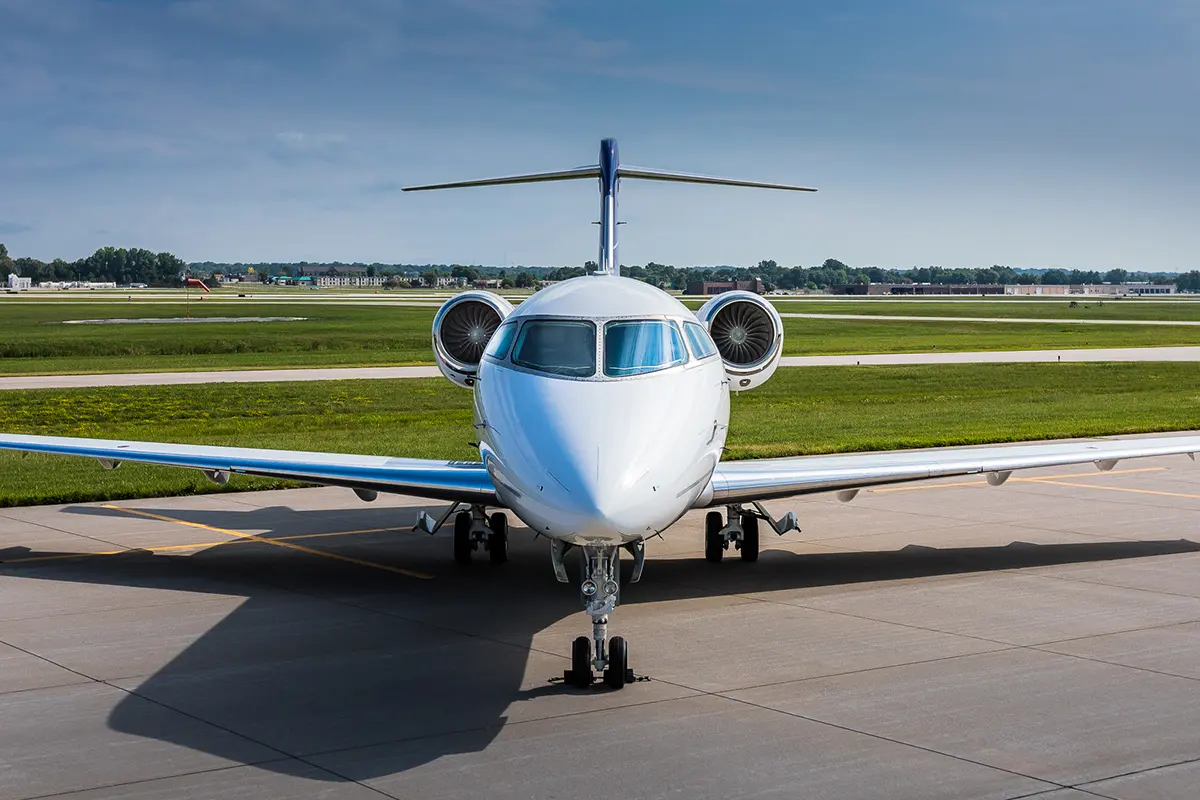
Two decades after its maiden voyage, the Challenger 300 has maintained its place as one of the most comfortable, economical, and reliable business jets on the market. The enduring appeal of Bombardier’s super-midsize aircraft is its combination of style and practicality and its balance of luxury and economy.
The Challenger 300 design was developed after two years of market research by Bombardier, custom-tailored to address corporate executives’ key requirements and priorities.[1] It provides a cost-effective step up for light and mid-size jet operators who are outgrowing their smaller aircraft.
Although Bombardier is now one of the world’s leading aircraft manufacturers, the Canadian company was founded in 1942 to produce passenger snowmobiles. Over the next few decades, it grew into a successful producer of snow-going vehicles for freight, personnel, and individual transport (including the Ski-Doo personal snowmobiles). In the 1970s, Bombardier branched out into rail transportation, developing urban mass-transit solutions (including the Montreal subway system) as well as innovating in long-range high-speed rail transportation.
The company didn’t enter aviation until the 1980s when it purchased Canadair (manufacturer of the Challenger widebody business jets) and began the development of the Canadair Regional Jet commercial aircraft. By the 1990s, it had acquired Learjet and its family of small business jets as well as developing the ultra-long-range Global Express family of large business jets.[2] Today, Bombardier Business Aircraft has over 4,700 aircraft in operation in more than 115 countries.
In 1995, Bombardier launched the revolutionary Flexjet fractional ownership program, an innovative private business jet solution for individuals and companies. The program (and the numerous others like it that have sprung up in the years since) enables participants to purchase shares in a business aircraft, providing them an annual flight time entitlement. This option enables potential owners to experience the convenience and luxury of business jets, familiarizing them with the aircraft and increasing the chances they will choose to purchase one of their own as their business travel needs grow.

The super-midsize Challenger 300 was a “clean sheet” design that bridged the gap between Bombardier’s nimble, efficient Learjet series of small jets and its larger, Challenger 600 series jets. These three progressively larger families of aircraft allow customers to stay within the Bombardier business jet family as their travel requirements evolve.
When it was introduced at the Paris Air Show in 1999, the new model was named the Continental. Its name emphasized its impressive 3,100-nautical mile (5,741 km)
range, measured with eight passengers and with NBAA instrument flight rules (IFR) reserves, which allows it to travel non-stop between any major city in the contiguous United States.[3] From its original production facility in Calgary, Alberta, Bombardier advertised its direct travel capability to eastern Canada as well as the far-flung cities of Honolulu, Hawaii, Reykjavik, Iceland, and San Juan, Puerto Rico. From Geneva International Airport in Switzerland, it can fly non-stop throughout Europe, across the Atlantic Ocean, and well into northern Africa.
By the time it earned its type approvals from Transport Canada and the United States Federal Aviation Administration (FAA) in 2003, the Continental had been rechristened the Challenger 300. Its name change encouraged prospective buyers to more closely associate it with the dependable, economical Challenger 604, which was the value-for-money leader among large business jets.[4]
At the time the Challenger 300 obtained its full type approvals (a process that was accomplished in record-breaking time), it was the only super-midsize jet designed to meet the latest standards of Transport Canada 525, U.S. Federal Aviation Administration FAR 25, and European Joint Aviation Authorities JAR 25 regulations as well as reduced vertical separation minima (RVSM) regulations. Within weeks of its approvals, the Challenger soared into the headlines, demonstrating its impressive capabilities by setting two new world speed records.
On June 11, 2003, the Challenger 300 flew from Miami, Florida to Seattle, Washington, with a full eight-passenger payload in just five hours and 48 minutes.[5] The next day, it shattered an existing record by flying Boston to Le Bourget in just six hours, 8 minutes. Both records were sanctioned by the U.S. National Aeronautic Association (NAA) and an NAA official was onboard for each flight.[6]

The Challenger 300 is powered by two Honeywell HTF 7000 engines with 6,826 pounds of thrust. This allows it to reach a maximum speed of Mach .82 and a typical cruise speed of Mach .80.[7] According to Bombardier, the Challenger 300’s slender 1.15m-high winglets improve its efficiency, reducing lift-induced drag by around 17% in the cruise. At 48.5 m2 (520 ft2), the Challenger 300’s wing is the smallest in the super-midsize class.[8] The Challenger 300 features supercritical wings with a fixed leading edge and 27% sweep angle.
For a maximum gross-weight aircraft on a standard day, Bombardier projects that the Challenger 300 can climb to FL 410 in 18 minutes while burning 1000 pounds of fuel. This responsiveness and quick climb time enable the Challenger 300 to easily overcome most weather issues and the opposing air traffic, which can improve the probability of getting direct routing to the destination.[9] Its maximum altitude is 45,000 ft.
A significant feature of the Challenger 300 is its short takeoff distance of 4,810 ft (1,466 m) and landing distance of 2,600 ft (792 m). These allow it to access many airfields with shorter or more limited runways than many other super-mid-size jets, including the Gulfstream G200 (which requires a runway of 6,991 ft with a comparable landing distance) and the Dassault Falcon 2000 (which requires a runway of 5,100 ft, although it requires only 2,150 ft of landing distance).[10] This impressively flexible takeoff ability and relatively short landing distance requirement dramatically expands the range of potential destinations that the Challenger 300 can access, increasing its practical value to owners and operators.

The Challenger 300 offers more cabin space—than any super-midsize business jet. It is larger than its in-class competitors, including the Falcon 50 and the Citation X, and its cabin configuration contributes to its feeling of overly spaciousness. Its stand-up cabin offers just over six feet of height, and it features a flat, level floor rather than a sunken aisle between elevated seats. Although its standard configuration is eight double-club seats, two seats can be replaced with a comfortable three-passenger divan (enabling seating for 9) that also folds into a lay-flat bed. One additional belted seat in the lavatory raises the maximum passenger capacity to 10.
What sets the Challenger 300 design apart is its attention to detail. The leather-clad seating is spacious, comfortable, and roomy, eschewing the common sharply angled overheads in favor of extra windows and full-size reclining seats. Cabin amenities include a galley with refrigerator, microwave, and meal prep center, forward wardrobe, and flushing, fully-enclosed lavatory with a fully-stocked sink area. The spacious luggage area (offering 3 square meters of space) is easily accessible in-flight to the rear of the lavatory; it can accommodate a substantial amount of luggage, including bulky items such as skis and golf clubs. If equipped, WiFi and a variety of tablet-integrated information/entertainment packages allow easy integration with personal mobile tech devices.
Bombardier also offers new cabin enhancements for older Challenger 300 models, including tech upgrade packages, custom-crafted stone flooring, and conference tables that feature a single-pillar pedestal for ergonomically comfortable and spacious seating.[11]
The Challenger 300’s flight deck features a Rockwell Collins Pro Line 21 integrated avionics suite, displayed on four 12”x10” LCD (liquid crystal display) displays in the forward instrument panel. A single flight-management/global-positioning system comes standard, with optional dual attitude heading/reference systems. The standard Engine Indication and Crew Alerting System gives pilots engine performance information such as fuel flow, oil and turbine temperatures, and environmental control information. Other standard included systems include the Enhanced Ground Proximity Warning System and Traffic Collision Avoidance System.[12]
The outboard LCDs act as the primary flight displays (PFD), with an attitude director indicator on the top half and a horizontal situation indicator on the bottom half. The inboard LCDs are multifunction displays (MFD), showing engine indication and crew alerting system, navigation, and system synoptics available. A full-time radio bar along the bottom edge of the MFD shows tuned frequencies. Instead of an overhead panel, the Challenger 300 sports an overhead emergency exit hatch, which is required since all four cockpit windows are fixed. The system control panels are logically arranged on the center pedestal, minimizing visual and aural clutter.[13]
Bombardier offers numerous upgrades for older-generation Challenger 300 avionics systems, including the future area navigation system (FANS) over Iridium hardware, which facilitates pilot communication with air traffic control and allows aircraft to fly over certain routes in North America, the Atlantic, and Europe. The system also meets the 2020 ADS-B out compliance deadline.[14] The Pro Line 21™ Advanced Upgrade for Challenger 300A features a more robust, feature-rich flight management system, including LPV technology; MFD with enhanced Integrated Flight Information System (IFIS); FANS 1/A for more efficient use of trans-Atlantic routing; synthetic vision system to enhance operational safety in all weather; MultiScan™ weather radar to avoid damaging turbulence, icing, and hail; and ARINCDirectSM flight support services for comprehensive flight planning and cabin connectivity.[15]

The Challenger 300 aircraft has become one of the most popular aircraft in the super mid category. Production of the original Challenger 300 ended in 2014 after Bombardier had delivered a total of 457 aircraft; 454 of those aircraft remain in operation. Once production of the original Challenger 300 ended, Bombardier transitioned production to the Challenger 350, which retained most of the 300’s features while enhancing the standard avionics package, slightly increasing the range, and updating the cabin design and entertainment packages.[16] In July 2020, Bombardier delivered its milestone 350th Challenger 350 aircraft, marking the aircraft’s sixth consecutive year as the world’s most delivered super-midsized jet.[17]
The Challenger 300 series jets have been popular not only with individual owner-operators but also with fractional share and charter fleet operators selling jet cards. Flexjet introduced the Challenger 300 to service in 2004. It currently operates 32 Challenger 300s as part of its fleet.
Upgrading to a super-midsized business jet like the Challenger 300 series can empower your business to reduce or avoid commercial airline travel, avoiding wasted time navigating TSA, flight delays, and potential exposure to health hazards. Aircraft used for qualified business purposes, such as Part 91 business use flights, can usually be depreciated under a modified accelerated cost recovery system over a period of five years or using the alternative depreciation system with a six-year recovery period (although using the aircraft for non-business purposes can impact the allowable yearly depreciation deduction). The 2017 Tax Cuts & Jobs Act may allow qualified individuals and businesses to deduct up to 100 percent of the cost of a new or used aircraft purchased after September 27, 2017, and placed in service before January 1, 2023. Because of this, there’s no time like the present to take a look at the benefits and cost savings of purchasing a Challenger 300 to upgrade your business jet.
The Challenger 300 series offers operating costs equivalent to or better than current super-midsize jets. When the aircraft made its maiden flight in 2001, it demonstrated impressive operating costs of $770 per hour and the ability for relatively short-field performance. The Challenger 300 can burn as little as 178 gallons of fuel per hour when flying at a high-speed cruise of .82 Mach.[18]
The Challenger 300 series also offers comparatively low maintenance and operations costs, offering a lower total variable cost (an aggregate of fuel expense, maintenance labor expense, scheduled parts expense, and miscellaneous trip expense) than the Gulfstream G200 or Falcon 2000, according to Conklin & de Decker. The total variable cost for the Challenger computes at $2,784 per hour, lower than its closest competitors.[19]
Currently, the Challenger 300 has 5.3% of its fleet listed for sale, with an average of two units changing hands per month on the resale market. Average resale cost, according to Aircraft Bluebook, ranges from $9 million for a 2010 model to $11 million for a 2014 model.
Challenger 300 series aircraft require 12, 24, 36, 48, 60, 96, and 144-month inspections as well as 600, 1200, 2400 and 3000-hour inspections. Over the long haul, the service requirements for the Challenger 300 series are more economical than its counterparts and require significantly less overall downtime.
At Elliott Jets, we’ve sold and acquired numerous Challenger 300 and 350s for customers all over the world. If you’d like to purchase or upgrade a Challenger 300 series aircraft, contact us today.
[1] “Bombardier Challenger 300, Global Express and Skyjet Europe to debut at European show.” www.bombardier.com. 5 May 2003.
[2] “History.” www.bombardier.com, accessed 8 Nov 2020.
[3] “Bombardier Challenger 300 Makes Canadian Debut In Calgary.” www.bombardier.com, 8 Jul 2003.
[4] “FLIGHT TEST: Bombardier Challenger 300 – Polished player.”FlightGlobal.com. 2 Feb 2004.
[5] “Bombardier Challenger 300 Sets World Record with Miami-Seattle Flight.” www.bombardier.com, 11 Jun 2003.
[6] “Bombardier Challenger 300 makes Canadian debut in Calgary.” www.bombardier.com, 8 Jul 2003.
[7] “Challenger 300 Factsheet” (PDF). Bombardier. 2006.
[8] “FLIGHT TEST: Bombardier Challenger 300 – Polished player.”FlightGlobal.com. 2 Feb 2004.
[9] FLIGHT TEST: Bombardier Challenger 300 – Polished player.”FlightGlobal.com. 2 Feb 2004.
[10] Chase, Mike. “Gulfstream G200 vs Challenger 300 vs Falcon 2000.” AVBuyer.com. 01 Apr 2008.
[11] Zazulia, Nick. “Bombardier Drops a Dozen Upgrade Options for Business Jets.” Aviationtoday.com. 19 Mar 2018.
[12] Hebert, Joshua Marc. “CHALLENGER 300 VS. GULFSTREAM G280.” Magellanjets.com. 10 Aug 2020.
[13] Ibid.
[14] Zazulia, Nick. “Bombardier Drops a Dozen Upgrade Options for Business Jets.” Aviationtoday.com. 19 Mar 2018.
[15] “Pro Line 21 Avionics Upgrade.” Businessaircraft.bombardier.com.
[16] “Challenger 300 vs Challenger 350.” Westpalmjets.com.
[17] “Bombardier Challenger 350 Aircraft Reaches Milestone 350th Delivery.” Globenewswire.com, 9 Jul 2020.
[18] Hebert, Joshua Marc. “CHALLENGER 300 VS. GULFSTREAM G280.” Magellanjets.com. 10 Aug 2020.
[19] Chase, Mike. “Gulfstream G200 vs Challenger 300 vs Falcon 2000.” AVBuyer.com. 01 Apr 2008.